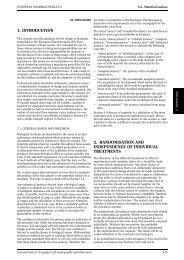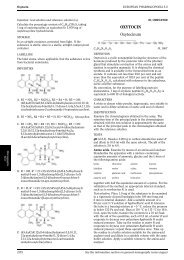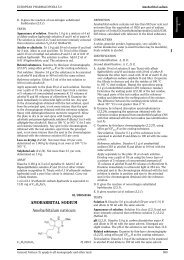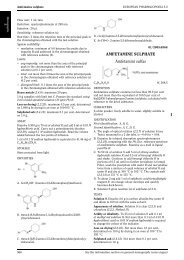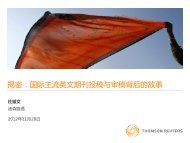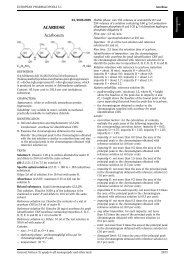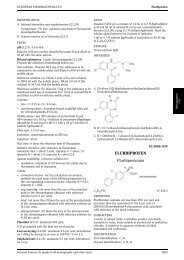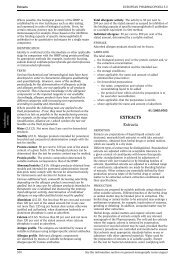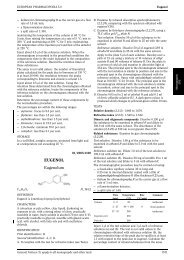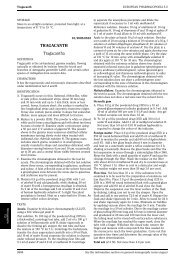ALLOPURINOL Allopurinolum
ALLOPURINOL Allopurinolum
ALLOPURINOL Allopurinolum
Create successful ePaper yourself
Turn your PDF publications into a flip-book with our unique Google optimized e-Paper software.
EUROPEAN PHARMACOPOEIA 5.0 Allopurinol<br />
IDENTIFICATION<br />
First identification: A.<br />
Second identification: B, C, D.<br />
A. Examine by infrared absorption spectrophotometry<br />
(2.2.24), comparing with the spectrum obtained with<br />
allantoin CRS.<br />
B. Examine the chromatograms obtained in the test<br />
for related substances. The principal spot in the<br />
chromatogram obtained with test solution (b) is similar<br />
in position, colour and size to the principal spot in the<br />
chromatogram obtained with reference solution (a).<br />
C. Boil 20 mg with a mixture of 1 ml of dilute sodium<br />
hydroxide solution R and 1 ml of water R. Allowtocool.<br />
Add 1 ml of dilute hydrochloric acid R. To0.1mlofthe<br />
solution add 0.1 ml of a 100 g/l solution of potassium<br />
bromide R, 0.1 ml of a 20 g/l solution of resorcinol R and<br />
3mlofsulphuric acid R. Heatfor5minto10minona<br />
water-bath. A dark blue colour develops, which becomes<br />
red after cooling and pouring into about 10 ml of water R.<br />
D. Heat about 0.5 g. Ammonia vapour is evolved, which<br />
turns red litmus paper R blue.<br />
TESTS<br />
Solution S. Dissolve0.5gincarbon dioxide-free water R,<br />
with heating if necessary, and dilute to 100 ml with the same<br />
solvent.<br />
Acidity or alkalinity. To5mlofsolutionSadd5mlof<br />
carbon dioxide-free water R,0.1mlofmethyl red solution R<br />
and 0.2 ml of 0.01 M sodium hydroxide. Thesolutionis<br />
yellow. Add 0.4 ml of 0.01 M hydrochloric acid. Thesolution<br />
is red.<br />
Optical rotation (2.2.7). The angle of optical rotation,<br />
determined on solution S, is −0.10° to + 0.10°.<br />
Reducing substances. Shake1.0gwith10mlofwater R<br />
for 2 min. Filter. Add 1.5 ml of 0.02 M potassium<br />
permanganate. The solution must remain violet for at least<br />
10 min.<br />
Related substances. Examine by thin-layer chromatography<br />
(2.2.27), using a suitable cellulose for chromatography R as<br />
the coating substance.<br />
Test solution (a). Dissolve0.10gofthesubstancetobe<br />
examined in 5.0 ml of water R with heating. Allow to<br />
cool. Dilute to 10 ml with methanol R. Use the solution<br />
immediately after preparation.<br />
Test solution (b). Dilute 1 ml of test solution (a) to 10 ml<br />
with a mixture of 1 volume of methanol R and 1 volume of<br />
water R.<br />
Reference solution (a). Dissolve 10 mg of allantoin CRS in a<br />
mixture of 1 volume of methanol R and 1 volume of water R<br />
and dilute to 10 ml with the same mixture of solvents.<br />
Reference solution (b). Dissolve 10 mg of urea R in 10 ml<br />
of water R. Dilute 1 ml of this solution to 10 ml with<br />
methanol R.<br />
Reference solution (c). Mix 1 ml of reference solution (a)<br />
and 1 ml of reference solution (b).<br />
Apply to the plate 10 µl of test solution (a) and 5 µl each of<br />
test solution (b), reference solution (a), reference solution (b)<br />
and reference solution (c). Develop over a path of 10 cm<br />
using a mixture of 15 volumes of glacial acetic acid R,<br />
25 volumes of water R and 60 volumes of butanol R. Allow<br />
the plate to dry in air. Spray the plate with a 5 g/l solution<br />
of dimethylaminobenzaldehyde R in a mixture of 1 volume<br />
of hydrochloric acid R and 3 volumes of methanol R. Dry<br />
the plate in a current of hot air. Examine in daylight after<br />
30 min. Any spot in the chromatogram obtained with test<br />
solution (a), apart from the principal spot, is not more intense<br />
than the spot in the chromatogram obtained with reference<br />
solution (b) (0.5 per cent). The test is not valid unless the<br />
chromatogram obtained with reference solution (c) shows<br />
two clearly separated principal spots.<br />
Loss on drying (2.2.32). Not more than 0.1 per cent,<br />
determined on 1.000 g by drying in an oven at 100-105 °C.<br />
Sulphated ash (2.4.14). Not more than 0.1 per cent,<br />
determined on 1.0 g.<br />
ASSAY<br />
Dissolve 120.0 mg in 40 ml of water R. Titratewith<br />
0.1 M sodium hydroxide, determining the end-point<br />
potentiometrically (2.2.20).<br />
1mlof0.1 M sodium hydroxide is equivalent to 15.81 mg<br />
of C 4H 6N 4O 3.<br />
IMPURITIES<br />
A. glyoxylic acid,<br />
B. urea.<br />
<strong>ALLOPURINOL</strong><br />
<strong>Allopurinolum</strong><br />
01/2005:0576<br />
C 5H 4N 4O M r 136.1<br />
DEFINITION<br />
1,5-Dihydro-4H-pyrazolo[3,4-d]pyrimidin-4-one.<br />
Content: 98.0 per cent to 102.0 per cent (dried substance).<br />
CHARACTERS<br />
Appearance: whiteoralmostwhitepowder.<br />
Solubility: veryslightlysolubleinwaterandinalcohol.It<br />
dissolves in dilute solutions of alkali hydroxides.<br />
IDENTIFICATION<br />
First identification: B.<br />
Second identification: A, C, D.<br />
A. Dissolve10mgin1mlofa4g/lsolutionofsodium<br />
hydroxide R and dilute to 100.0 ml with a 10.3 g/l<br />
solution of hydrochloric acid R. Dilute10.0mlof<br />
this solution to 100.0 ml with a 10.3 g/l solution of<br />
hydrochloric acid R. Examined between 220 nm and<br />
350 nm (2.2.25), the solution shows an absorption<br />
maximum at 250 nm and an absorption minimum at<br />
231nm.Theratiooftheabsorbancemeasuredatthe<br />
absorption minimum at 231 nm to that measured atthe<br />
absorption maximum at 250 nm is 0.52 to 0.62.<br />
B. Infrared absorption spectrophotometry (2.2.24).<br />
Preparation: discs.<br />
Comparison: allopurinol CRS.<br />
GeneralNotices(1)applytoallmonographsandothertexts 943
Allopurinol EUROPEAN PHARMACOPOEIA 5.0<br />
C. Dissolve0.3gin2.5mlofdilute sodium hydroxide<br />
solution R and add 50 ml of water R. Add slowly and<br />
with shaking 5 ml of silver nitrate solution R1. Awhite<br />
precipitate is formed which does not dissolve on the<br />
addition of 5 ml of ammonia R.<br />
D. Thin-layer chromatography (2.2.27).<br />
Test solution. Dissolve 20 mg of the substance to be<br />
examined in concentrated ammonia R and dilute to<br />
10 ml with the same solvent.<br />
Reference solution. Dissolve 20 mg of allopurinol CRS<br />
in concentrated ammonia R and dilute to 10 ml with the<br />
same solvent.<br />
Plate: TLC silica gel F 254 plate R.<br />
Mobile phase: ethanol R, methylene chloride R<br />
(40:60 V/V).<br />
Application: 10µl.<br />
Development: over2/3oftheplate.<br />
Drying: inair.<br />
Detection: examine in ultraviolet light at 254 nm.<br />
Results: the principal spot in the chromatogram obtained<br />
with the test solution is similar in position and size to<br />
the principal spot in the chromatogram obtained with<br />
the reference solution.<br />
TESTS<br />
Related substances. Liquid chromatography (2.2.29).<br />
Prepare the solutions immediately before use. Store them<br />
and inject them at 8 °C using a cooled autosampler.<br />
Test solution (a). Dissolve 25.0 mg of the substance to be<br />
examined in 2.5 ml of a 4 g/l solution of sodium hydroxide R<br />
and dilute immediately to 50.0 ml with the mobile phase.<br />
Test solution (b). Dissolve 20.0 mg of the substance to be<br />
examined in 5.0 ml of a 4 g/l solution of sodium hydroxide R<br />
and dilute immediately to 250.0 ml with the mobile phase.<br />
Reference solution (a). Dilute 2.0 ml of test solution (a)<br />
to 100.0 ml with the mobile phase. Dilute 5.0 ml of this<br />
solution to 100.0 ml with the mobile phase.<br />
Reference solution (b). Dissolve 5.0 mg of allopurinol<br />
impurity A CRS, 5.0mgofallopurinol impurity B CRS and<br />
5.0 mg of allopurinol impurity C CRS in 5.0 ml of a 4 g/l<br />
solution of sodium hydroxide R and dilute immediately to<br />
100.0 ml with the mobile phase. Dilute 1.0 ml of this solution<br />
to 100.0 ml with the mobile phase.<br />
Reference solution (c). Dissolve 20.0 mg of allopurinol CRS<br />
in 5.0 ml of a 4 g/l solution of sodium hydroxide R and<br />
dilute immediately to 250.0 ml with the mobile phase.<br />
Column:<br />
— size: l =0.25m,Ø=4.6mm,<br />
— stationary phase: octadecylsilyl silica gel for<br />
chromatography R (5 µm).<br />
Mobile phase: 1.25g/lsolutionofpotassium dihydrogen<br />
phosphate R.<br />
Flow rate: 1.4ml/min.<br />
Detection: spectrophotometer at 230 nm.<br />
Injection: 20 µl of test solution (a) and reference solutions (a)<br />
and (b).<br />
Run time: twice the retention time of allopurinol.<br />
Elution order: impurity A, impurity B, impurity C,<br />
allopurinol.<br />
Retention time: allopurinol = about 10 min.<br />
System suitability: reference solution (b):<br />
— resolution: minimum 1.1 between the peaks due to<br />
impurity B and impurity C.<br />
Limits:<br />
— impurity A: not more than twice the area of the principal<br />
peak in the chromatogram obtained with reference<br />
solution (a) (0.2 per cent),<br />
— impurity B: not more than the area of the principal peak<br />
in the chromatogram obtained with reference solution (a)<br />
(0.1 per cent),<br />
— impurity C: not more than the area of the corresponding<br />
peak in the chromatogram obtained with reference<br />
solution (b) (0.1 per cent),<br />
— any other impurity: for each impurity, not more than the<br />
area of the principal peak in the chromatogram obtained<br />
with reference solution (a) (0.1 per cent),<br />
— sum of impurities other than A, B and C: notmorethan<br />
3 times the area of the principal peak in the chromatogram<br />
obtained with reference solution (a) (0.3 per cent),<br />
— disregard limit: 0.5 times the area of the principal peak<br />
in the chromatogram obtained with reference solution (a)<br />
(0.05 per cent).<br />
Impurities D and E. Liquid chromatography (2.2.29).<br />
Prepare the solutions immediately before use. Store them<br />
andinjectthemat8°Cusingacooledautosampler.<br />
Solution A: 1.25g/lsolutionofpotassium dihydrogen<br />
phosphate R.<br />
Test solution. Dissolve50.0mgofthesubstancetobe<br />
examined in 5.0 ml of a 4 g/l solution of sodium hydroxide R<br />
and dilute immediately to 100.0 ml with solution A.<br />
Reference solution. Dissolve5.0mgofallopurinol<br />
impurity D CRS and 5.0 mg of allopurinol impurity E CRS<br />
in5.0mlofa4g/lsolutionofsodium hydroxide R and<br />
dilute immediately to 100.0 ml with solution A. Dilute 1.0 ml<br />
of this solution to 100.0 ml with solution A.<br />
Column:<br />
— size: l =0.05m,Ø=4.6mm,<br />
— stationary phase: base-deactivated octadecylsilyl silica<br />
gel for chromatography R (3 µm).<br />
Mobile phase: methanol R, 1.25g/lsolutionofpotassium<br />
dihydrogen phosphate R (10:90 V/V).<br />
Flow rate: 2ml/min.<br />
Detection: spectrophotometer at 230 nm.<br />
Injection: 20µl.<br />
Run time: 1.5 times the retention time of impurity E.<br />
Retention times: impurity D = about 3.6 min;<br />
impurity E = about 4.5 min.<br />
System suitability: reference solution:<br />
— resolution: minimum 2.0 between the peaks due to<br />
impurity D and impurity E.<br />
Limits:<br />
— impurity D: not more than the area of the corresponding<br />
peak in the chromatogram obtained with the reference<br />
solution (0.1 per cent),<br />
— impurity E: notmorethantheareaofthecorresponding<br />
peak in the chromatogram obtained with the reference<br />
solution (0.1 per cent).<br />
Heavy metals (2.4.8): maximum 20 ppm.<br />
1.0 g complies with limit test C. Prepare the standard using<br />
2mloflead standard solution (10 ppm Pb) R.<br />
Loss on drying (2.2.32): maximum 0.5 per cent, determined<br />
on1.000gbydryinginanovenat100-105°C.<br />
Sulphated ash (2.4.14): maximum 0.1 per cent, determined<br />
on 1.0 g.<br />
944 See the information section on general monographs (cover pages)
EUROPEAN PHARMACOPOEIA 5.0 Almagate<br />
ASSAY<br />
Liquid chromatography (2.2.29) as described in the test for<br />
related substances with the following modification.<br />
Injection: test solution (b) and reference solution (c).<br />
Calculate the percentage content of C5H4N4O from the areas<br />
of the peaks and the declared content of allopurinol CRS.<br />
IMPURITIES<br />
Specified impurities: A, B, C, D, E.<br />
C. 2 ml of the solution prepared under identification test B<br />
gives the reaction of magnesium (2.3.1).<br />
A. R1=NH2,R2=H:5-amino-1H-pyrazole-4-carboxamide, B. R1 = NH2,R2=CHO:5-(formylamino)-1H-pyrazole-4 carboxamide,<br />
TESTS<br />
pH (2.2.3): 9.1to9.7. Disperse 4.0 g in 100 ml of carbon dioxide-free water R, stir<br />
for 2 min and filter.<br />
Neutralising capacity. Carry out the test at 37 °C. Disperse<br />
0.5gin100mlofwater R, heat, add 100.0 ml of 0.1 M<br />
hydrochloric acid, previously heated and stir continuously;<br />
the pH (2.2.3) ofthesolutionbetween5minand20minis<br />
not less than 3.0 and not greater than 4.5. Add 10.0 ml of<br />
0.5 M hydrochloric acid, previously heated, stir continuously<br />
for 1 h and titrate with 0.1 M sodium hydroxide to pH 3.5;<br />
not more than 20.0 ml of 0.1 M sodium hydroxide is<br />
required.<br />
Chlorides (2.4.4): maximum 0.1 per cent.<br />
Dissolve 0.33 g in 5 ml of dilute nitric acid R and dilute to<br />
100 ml with water R. 15 ml of the solution complies with the<br />
D.R1=O-CH2-CH3,R2=H:ethyl5-amino-1H-pyrazole-4 carboxylate,<br />
limit test for chlorides. Prepare simultaneously the standard<br />
by diluting 0.7 ml of dilute nitric acid R to 5 ml with water R<br />
E.R1=O-CH2-CH3,R2=CHO:ethyl5-(formylamino)-1H pyrazole-4-carboxylate,<br />
and adding 10 ml of chloride standard solution (5 ppm Cl) R.<br />
Sulphates (2.4.13): maximum 0.4 per cent.<br />
Dissolve 0.25 g in 5 ml of dilute hydrochloric acid R<br />
and dilute to 100 ml with distilled water R. 15mlofthe<br />
solution complies with the limit test for sulphates. Prepare<br />
simultaneously the standard by adding 0.8 ml of dilute<br />
hydrochloric acid R to 15 ml of sulphate standard solution<br />
(10 ppm SO4)R. Sodium: maximum 150 ppm.<br />
C. 5-(4H-1,2,4-triazol-4-yl)-1H-pyrazole-4-carboxamide.<br />
Atomic absorption spectrometry (2.2.23, Method I).<br />
Test solution. Dissolve 0.25 g in 50 ml of a 103 g/l solution<br />
01/2005:2010<br />
corrected<br />
of hydrochloric acid R.<br />
Reference solutions. Prepare the reference solutions using<br />
sodium standard solution (200 ppm Na) R, dilutedas<br />
ALMAGATE<br />
necessary with a 103 g/l solution of hydrochloric acid R.<br />
Heavy metals (2.4.8): maximum 20 ppm.<br />
Almagatum<br />
Dissolve 1.0 g in dilute hydrochloric acid R and dilute to<br />
20.0 ml with the same acid. 12 ml of the solution complies<br />
Al2Mg6C2O20H14,4H2O Mr 630 withlimittestA.Preparethestandardusinglead standard<br />
solution (1 ppm Pb) R.<br />
DEFINITION<br />
Loss on ignition: 43.0 per cent to 49.0 per cent, determined<br />
Hydrated aluminium magnesium hydroxycarbonate. on 1.000 g by ignition at 900 °C.<br />
Content:<br />
Microbial contamination. Total viable aerobic count (2.6.12)<br />
— aluminium: 15.0 per cent to 17.0 per cent (calculated not more than 10<br />
as Al2O3), — magnesium: 36.0 per cent to 40.0 per cent (calculated<br />
as MgO),<br />
— carbonic acid: 12.5 per cent to 14.5 per cent (calculated<br />
as CO2). CHARACTERS<br />
Appearance: white or almost white, fine crystalline powder.<br />
Solubility: practically insoluble in water, in alcohol and<br />
in methylene chloride. It dissolves with effervescence and<br />
heating in dilute mineral acids.<br />
IDENTIFICATION<br />
A. Infrared absorption spectrophotometry (2.2.24).<br />
Comparison: Ph. Eur. reference spectrum of almagate.<br />
B. Dissolve 150 mg in dilute hydrochloric acid R and dilute<br />
to20mlwiththesameacid.2mlofthesolutiongivesthe<br />
reaction of aluminium (2.3.1).<br />
3 micro-organisms per gram determined by<br />
plate count. It complies with the tests for Escherichia coli<br />
and Pseudomonas aeruginosa (2.6.13).<br />
ASSAY<br />
Aluminium. Dissolve 1.000 g in 5 ml of hydrochloric acid R,<br />
heating if necessary. Allow to cool to room temperature<br />
and dilute to 100.0 ml with water R (solution A). Introduce<br />
10.0 ml of solution A into a 250 ml conical flask, add 25.0 ml<br />
of 0.05 M sodium edetate,20mlofbuffer solution pH 3.5 R,<br />
40 ml of ethanol R and 2 ml of a freshly prepared 0.25 g/l<br />
solution of dithizone R in ethanol R. Titratetheexcessof<br />
sodium edetate with 0.05 M zinc sulphate until the colour<br />
changes from greenish-violet to pink.<br />
1mlof0.05 M sodium edetate is equivalent to 2.549 mg<br />
of Al2O3. Magnesium. Introduce 10.0 ml of solution A prepared in the<br />
assay of aluminium into a 500 ml conical flask, add 200 ml of<br />
water R, 20mloftriethanolamine R with shaking, 10 ml of<br />
GeneralNotices(1)applytoallmonographsandothertexts 945



